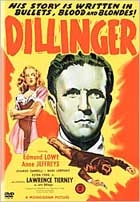
BUY IT
AT AMAZON: CLICK HERE!
STUDIO: Monogram Pictures
MSRP:
$13.98 RATED: Unrated
RUNNING TIME: 70 Mins.
SPECIAL FEATURES:
• Commentary by filmmaker John Milius, Director if 1973 Dillinger, with audio
interview excerpts of Screenwriter Philip Yordan
• Theatrical Trailer
This DVD is part of The Warner Brothers Film Noir
Boxed Set: Volume 02 (Purchase it from CHUD and save your dollar bills!).
There’s a tricky slope when deciding what films to put in a film noir boxed set, and I feel that Dillinger doesn’t really match up to those aspects that make noir what it wonderfully is. It’s possible that the exploits of Public Enemy No. One would have been more suitable for a Gangsters collection. But, as presented in the set, along with a variety of more palpable film noirs from their period in film history, Dillinger presents itself as being a little out of place.
Controversy surrounds the film tremendously. Today it feels a little tame compared to what we’ve seen (courtesy the number of filmmakers working since, like De Palma). Shrugging this off, way back when, there was a specific code the studios adhered to, which was not to present real-life criminals in a positive light. The forces conspiring against the portrayals could have been none other than J. Edgar Hoover and Hayes himself, although that’s conjecture on my part. Producers Maurice and Franklin King, working with the shoe stringiest of budgets, forewent the unofficial (yet official by the studios) embargo, attempting to sensationalize what audiences were clamoring for in print. The result?
The Flick
Dillinger is a short and brutally strange movie. It has some charm to it, but that can be credited to the larger-than-life portrayal of the man, the myth, and the folk legend who made the FBI fume and the public swoon over his exploitative nature during the Depression. This is a time which most of you know as a era in which America was really, really down. For those still in school, well, you see, just goddamned read a book. There.
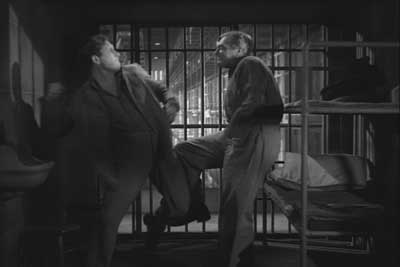
"Sissy this KICK, asshole!" he smugly said.
Laurence Tierney, who is billed sixth, is John Dillinger. He doesn’t really throw himself into the role (his first major one), as much as he creates one of the toughest presences around. It served him well too, as this persona helped elevate him into the status that encircled his whole career, onscreen and off. His Dillinger is a small time hood, who dreams big. He’s a quick thinker, a man of action, one who learns well and executes his items unlike those failed gangsters before him. Tierney’s also a cold hearted killer, able to quickly come to Judge Dredd terms in less than a millisecond, dispatching a bullet into his victims like your hands to the nearest beer (or CHUD popup). Tierney is ultimately self-assured, incredibly full of himself, and a shady mastermind. All of these traits would supply him well, until that is, a fateful day in the back of a movie theatre.
The film starts off with stock footage, with it being revealed that we’re in a movie theatre, waiting for Dillinger‘s dad to get up and talk. It’s very shoddy in presentation. Why would these throngs of people wait this long for a short talk with a man who really doesn’t understand his son? The answer is somewhat simple, but entirely confusing compared to the rest of the picture. It doesn’t fit. The one good ray of evil sunshine is that, while the mustachioed Mario is nowhere to be found, you in a sense learn a little bit about Dillinger‘s rise from nice country boy to thoroughly perverted killer, of sorts. This helps add to the film’s slapdash construction, forming cuts and scenes that don’t seem to fit together, but ultimately help in telling an interesting narrative.
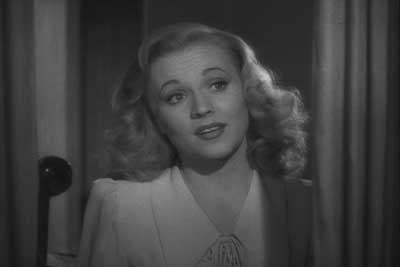
"I really am a front door Man, if you know what I mean…"
As we move on, Dillinger‘s short on the cash (like the rest of America, then and now), so he does the only animalistic thing he can do. Steal, and steal often, as they say. Except that it gets him thrown into the can, where he meets Specs Green (played very upper crust and skeptical by Edmund Lowe). Specs is the type of man you hear whispers about in the joint. A man who risked it all, and won, only to be caught. See, he stole $70,000.00, which in 1930’s money is a fucking million (or close). Dillinger‘s immediately drawn to his allure, since he understands and sees a little bit of his own modus operandi in Specs, that of figuring out where the money is, and then smashing it all down to steal for themselves. He pair quickly bond, and as Dillingers’ sentence is coming to a rather swift close, they make plans to do unto others how they wish to destroy the world. It’s not bad for a small time hood who wishes to become something else, at all costs, on his way to the top.
The way Dillinger gets Specs and crew (consisting of Ralph Lewis, Eduardo Ciannelli, Marc Lawrence and Elisha Cook Jr. – see I’d told you he’d pop up again!) out of their time for The Man™ is rather exciting. Hidden inside of a rather common instrument used for construction, the men escape and high tail it back to their encounter with Dillinger. This is where the fun begins. Dillinger, sensing retribution for his past transgressions, visits a diner where the waiter denied him previously (and thus set the catalyst for his jail time). Wishing to extend some smiles-all-around courtesy, he smashes a beer mug and stabs him bluntly and forcefully. This is the real John we’re starting to see emerge. A man with a quick temper and the means to execute his anger into the most sadistic of ways. Tierny nails this aspects quickly and gleefully efficiently, just like Dillinger finds his ways in the film itself.
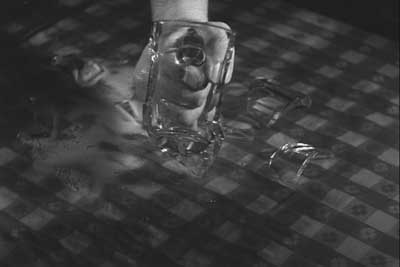
Mugovision never really caught on, the
end result being Death and all…
The rest of the film revolves around the crew, at the behest of Dillinger (who works his way up to their leader), going around and robbing various banks. Most are successes, some are complete and utter failures. The point being, in all of this, is that the film, as a whole, presents the necessary information to grasping a full understanding Dillinger, but to a point. In fact, I don’t think the film presents enough to get you to ultimately care about Dillinger and his gang. Moving at breakneck pace, the 70 minute film barley has time to catch its breath in between scouring stock footage from other films and securing its place among the rarities of the gangster genre, a slapped together film that barely works cohesively on its own.
That’s not to say that the film fails. In general, it succeeds, allowing you to go along the relatively bumpy and entertaining ride with Dillinger and his band of henchmen. It’s just you never quite fully understand who they are. I still don’t understand why his men take on to him in the ways they do. He treats them bluntly and coldly. Although there is a sense of camaraderie, it’s just not enough. Dillinger, on the other hand, you always know his true colors. Tierney is a success in bringing for the relatively simple emotions the hefty killer and shady mastermind brings from the real-life exploits to the cinematic ones. Most of the film’s action takes place off screen. I’m reminded of the scene where Dillinger pulls the trigger on two characters in a horrific series of shots that just primarily focused on his face. The effect is rather cold, cool and calculating it its shocking tendencies, but in reality, I just think it was cheaper for the King brothers, along with director Max Nosseck to just hint at what occurs rather than spend the money to show it. This happens throughout the film, especially in the beer mug-stabbing scene. Like the others, it is just implied, never shown. This is both frustrating and somewhat simplistically genius.
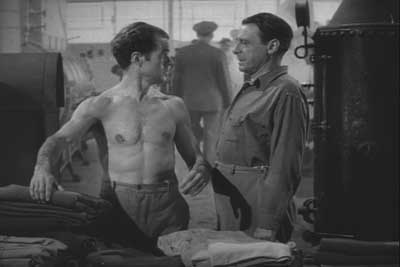
"Seriously Johnson, shave those Sasquatch things."
Some other people might be curiously enraged that the film liberally (and by that I mean – steals in massive quantities, like CHUD’s Special Edition, from other films of the era). Most notable is the films’ ripped-from-the-editing-bay presentation of Fritz Lang’s You Only Live Once. There’s a bravura set piece involving the police guarding a rather large stack of cash outside a Savings & Loan, and when the Gangsters descend upon them, in the rain with smoke bombs, all hell breaks loose. None of it was filmed for Dillinger. Whether or not you consider it to be thoroughly audacious when the camera swoops over to a nearby car that the eyes you see are Henry Fonda’s and not Laurence Tierney’s is besides the point. It works in context for both films. It’s a shame, but rather and incredibly ballsy of them, especially if you haven’t seen the amazing Lang film. Again, this is frustrating, and yet, somewhat simplistically creative in it’s budgetary restrictions.
The slapped together and holding-on-by-a-thread screenplay by Philip Yordan makes creative use of the set pieces to getting the narrative to quickly barrel along to its intended destination: that historical night in the back of a movie theatre. Granted, the events presented are entirely inaccurate, but it gives you the same sense of what could have occurred if avenues B where taken instead of A. It all ends up in the same place, though. You’ve got to remember that this film was meant to be a thrilling form of entertainment for audiences to escape in, as such, it was never meant to be taken as gospel. If you’re the type who takes everything as written in stone, Dillinger is probably best for you to skip.
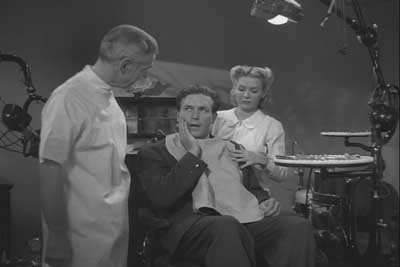
"Wait a sec, you said your name was Dr. Giggles?"
Dillinger also really doesn’t fit into the mold of the film noir genre, as I previous mentioned. It’s a tough sell, because first and foremost, it’s a gangster film all the way down to its loose skeleton of a story. Film noirs were centered around crime stories told through their murky visuals, while Dillinger, a crime story, has a very bright and straightforward presentation. Usually the anti-hero is someone you could stand behind on his journey into darkness (like Born To Kill), whereas Dillinger is the anti-hero, in the sense that he’s the goddamned simple and hard-assed villain, but an interesting one at that. The journey isn’t really present as much as it’s hinted at creating those rifts against comparing the film as a true film noir. These are just some of the opposing areas on the spectrum that I really don’t feel that Dillinger fits into the noir mode. As a crime film, hell yes, but as a film noir: homey don’t play that game, a funny man once said, before vanishing to family TV.
As a whole, Dillinger feels a little too rushed for my tastes. I can still understand its relative interesting qualities (such as Tierney and the ripped-from-the-headlines style of storytelling) that have made it of minor importance. It’s just that Dillinger isn’t really that spectacular. Fun, but nothing amazing.
6.0 out of 10
The Look
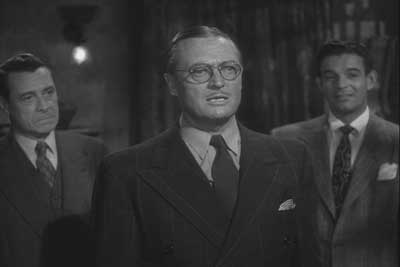
"I haven’t seen one that small since MTV Spring Break!"
Presented in the film’s original 1.33:1 aspect ratio. For such an older film, it looks terrific. There’s more than a few scratches and dirt problems with the print, but for as old as it is, WB did a nice job cleaning it up for your home video release.
7.5 out of 10
The Noise
The original audio, which has been updated to Dolby Digital 1.0 Mono. The audio is crystal clear and I had no major problems with it. In fact, it almost tried to kill me when I wasn’t looking. I had to run away, like I do to most deadlines and major life-changing events. Aurally, it’s pretty good for such an old film, one that could have served in the War if it didn’t chicken out!
7.5 out of 10
The Goodies
You get: a commentary track by the once-great John Milius with audio excerpts from screenwriter Philip Yordan. The track is rather disappointing. Milius suffers quite a bit from the play-by-play syndrome. Case in point: "look, there’s where he picks up the gun and now he’s gonna shot ’em." That’s not what he said word for word, but you get the gist, explaining what you’re seeing onscreen. Milius does have some informative things to say and when not pausing for what feels like eternity in most instances (he does this a lot), he expounds from a variety of topics. Things like his own 1973 film of Dillinger, his ideas towards the 1945 original, the history behind Dillinger and the ramifications of what was happening during that fateful era, violent crime (the folk heroes) as it appears against the white-collar criminals (the banks) and those (the public) who rallied around the criminals, on top of throwing out a reference to "Osama Bin Lay-den". That last part you can quote him on. When Yordan comes around, he’s a spitfire, spewing forth about the confines of the controversy against gangsters and the like, before segueing into discussing the Blacklist and how he aura of resentment solidified everyone into a purpose: fighting back. These instances aren’t as many as you might be lead to believe, but they do pepper Milius’ pauses when needed.
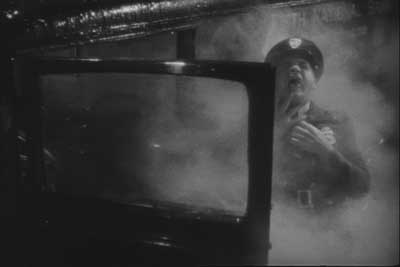
"Why Guttenberg!?! Why?!?"
Lastly, you also get the theatrical trailer (runtime: 2:05), which recalls the classic gangster imagery of Little Caesar and its ilk. The trailer is very scratchy and the sound is awful. But, it’s very kitschy and works like gangbusters.
4.5 out of 10
The Artwork
Scary! Dillinger‘s evil pale green face stares out, warning all who come in contact with him! Hell, his visage even killed a man by landing on him. That’s power! The lady beside him seems drawn to his innate Martianness, and I think she might be looking to score. Or not. Either way, it’s a cool classic representation of the original poster (I believe) and with the source of easy on the eyes primary colors; it works in drawing your attention to a very sordid subject. Not bad.
8.0 out of 10